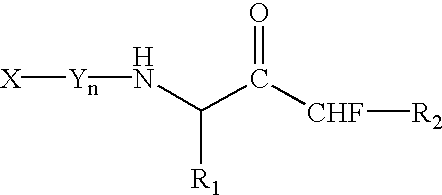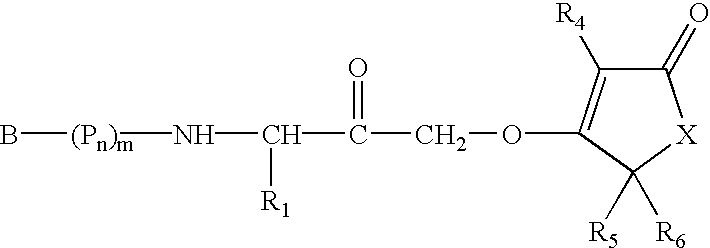Alpha-(1,3-dicarbonylenol ether) methyl ketones as cysteine protease inhibitors
a technology of dicarbonylenol ether and methyl ketones, which is applied in the field of dicarbonylenol ether methyl ketones as cysteine protease inhibitors, can solve the problems of phenoxy group toxicity, solubility, and use of diazoketones, and achieve the effect of improving solubility and toxicity profiles
- Summary
- Abstract
- Description
- Claims
- Application Information
AI Technical Summary
Benefits of technology
Problems solved by technology
Method used
Image
Examples
example 1
N-Morpholinecarbonyl-L-phenylalanyl-L-homophenylalanine-.alpha.-(4-oxy-5-p- henyl-4-cyclopentene-1,3-dione) methyl ketone
[0185] N-morpholinecarbonyl-L-phenylalanyl-L-homophenylalanine bromomethyl ketone (100 mg, 0.194 mmol), potassium fluoride (45 mg, 0.775 mmol), and 4-hydroxy-5-phenyl-4-cyclopentene-1,3-dione was placed in a 20 cm test tube equipped with a stirring bar and placed under an argon atmosphere. Next 3 ml of dry DMF was syringed into the reaction which was allowed to stir at room temperature until TLC (silica gel, CHCl.sub.3 / isopropanol:95- / 5) showed total loss of starting material. The reaction was then passed through a short plug of silica gel (ethyl acetate) and the solvent was removed in vacuo. The resulting material was purified by size exclusion chromatography (LH 20, methanol) and precipitated in ether to give a yellow powder after filtration. (m.p.=155-157.degree. C., IC.sub.50 Cathepsin B, 94 nM.)
example 2
N-Morpholinecarbonyl-L-phenylalanyl-L-homophenylalanyl-.alpha.-(4-ascorbit- yl) methyl ketone
[0186] N-morpholinecarbonyl-L-phenylalanine bromomethylketone (495 mg, 1 mmol), sodium ascorbate (380 mg, 2 equivalents), and potassium fluoride (116 mg, 2 equivalents) was placed in a 50 mL round bottom flask under an atmosphere of argon. Next, 5 ml of dry DMF was syringed in and the reaction was allowed to stir at room temperature overnight. The next day the reaction was filtered through celite and the solvents were removed in vacuo. The residue was dissolved in chloroform and the resulting solution was diluted with an equal volume of methylene-chloride to precipitate the unreacted sodium ascorbate. After filtration the solvent was removed in vacuo and the residue purified by size exclusion chromatography to give a white solid, mp 105-110.degree. C. IC.sub.50 Cathepsin B, 141 nM.
[0187] In a similar manner the following compounds were prepared: N-Morpholinecarbonyl-L-phenylalanyl-L-homophen...
example 3
Protocol for the in Vitro Evaluation of Inhibitors with Cathepsin B
[0189] Enzyme: Cathepsin B, purified from human liver, is from Enzyme Systems Products (Dublin, Calif.). The activity is 50 mU per ml at 30.degree. C., in 52 mM sodium phosphate, pH 6.2, 31 mM DTT, 2.1 mM EDTA, with 0.2 mM Z--Arg--Arg-7-amino-4-trifluoromethyl-coumarin as a substrate. Specific activity is 8330 mU per mg protein. (1 mU=1 nmol per min.)
[0190] Substrate Boc--Leu--Arg--Arg-7-amino-4-trifluoromethyl-coumarin-2HB- r is from Enzyme Systems Products (Dublin, Calif.) and is known to be a specific substrate for cathepsin B. A 20 mM solution is made in DMF and stored at 20.degree. C.
[0191] Candidate inhibitors are dissolved in DMF and diluted to 20 mM and stored at 20.degree. C. Dilutions are made in assay buffer.
[0192] The percent inhibition and the inhibitor concentration at which the enzyme is 50% inhibited (IC.sub.50) are determined as follows. Five .mu.l of assay buffer (50 mM potassium phosphate pH 6.2, 2...
PUM
| Property | Measurement | Unit |
|---|---|---|
| solubility | aaaaa | aaaaa |
| pH | aaaaa | aaaaa |
| total volume | aaaaa | aaaaa |
Abstract
Description
Claims
Application Information
 Login to View More
Login to View More - R&D
- Intellectual Property
- Life Sciences
- Materials
- Tech Scout
- Unparalleled Data Quality
- Higher Quality Content
- 60% Fewer Hallucinations
Browse by: Latest US Patents, China's latest patents, Technical Efficacy Thesaurus, Application Domain, Technology Topic, Popular Technical Reports.
© 2025 PatSnap. All rights reserved.Legal|Privacy policy|Modern Slavery Act Transparency Statement|Sitemap|About US| Contact US: help@patsnap.com



